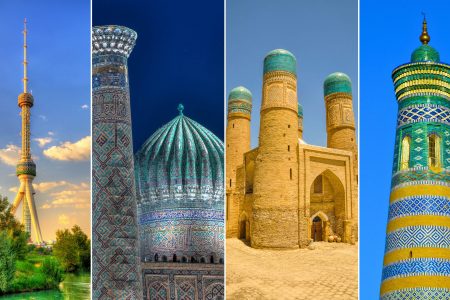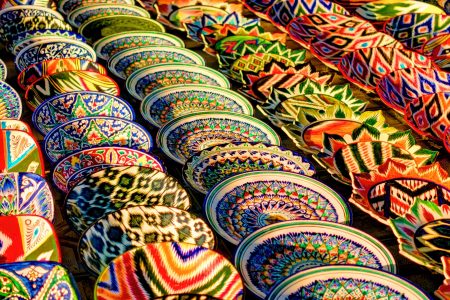20 million
Official: Kazakh, Russian
Astana
Borders: Russia, China, Kyrgyzstan, Uzbekistan, Turkmenistan
Tenge (KZT)
Cold winters (October-May) and hot summers (June-September).

Welcome to the heart of Central Asia, where modernity seamlessly merges with tradition, and breathtaking panoramas await you at every turn. Kazakhstan, the world’s largest landlocked country, unfolds as an exceptional travel destination, offering a unique experience at every step of your journey.
Located in Central Asia, Kazakhstan shares its borders with Russia to the north, China to the east, Kyrgyzstan, Uzbekistan, and Turkmenistan to the south, and the Caspian Sea to the west. In this fascinating country, where the contrasts between nomadic traditions and modern vibrancy create a rich and vivid tapestry, every corner of Kazakhstan tells a unique story. The capital, Nur-Sultan, formerly known as Astana since 2019, is a reflection of this duality. Amidst its sparkling skyscrapers piercing the sky and remnants of its cultural heritage, the city invites you on an architectural and artistic adventure. Admire the presidential palace, a masterpiece of neoclassical architecture, and immerse yourself in contemporary art through the numerous museums and galleries that punctuate the city. The official language is Kazakh, but Russian resonates in administration and business, reflecting the country’s diverse cultural heritage. With a population of around 18 million, Kazakhstan welcomes its visitors with warm hospitality, a reflection of its rich cultural history shaped by its strategic location on the Silk Road. The Kazakh economy, supported by natural resources such as oil, gas, minerals, and metals, positions the country as one of the world’s leading oil producers. The diversity of Kazakh landscapes, from vast steppes to snow-capped Tian Shan mountains, the Charyn Desert, and the lakes Balkhash, Zaysan, and Caspian, paints a natural canvas that invites awe.
The rich history of Kazakhstan, from ancient civilizations to Mongol domination and the influence of the Russian Empire, unfolds through archaeological sites, mausoleums, and remnants from the Soviet era. The majority practice of Islam, mainly Sunni, is an essential element of Kazakh cultural identity. The Baikonur Cosmodrome, the birthplace of the historic launch of the first human into space, Yuri Gagarin, testifies to Kazakhstan’s contribution to space exploration.
In summary, Kazakhstan awaits you with open arms, offering a unique destination that blends traditions, diverse natural landscapes, and a captivating history. It’s a call to adventure and discovery, where each moment immerses you in the rich cultural and natural palette of this gem in Central Asia.
The diversity of landscapes
From the magnificent Charyn Desert to the majestic peaks of the Tian Shan Mountains and the vast, endless steppes, Kazakhstan offers a breathtaking diversity of landscapes. Follow in the footsteps of nomads through lush valleys, discover brilliant blue lakes nestling between mountains, and immerse yourself in history as you explore ancient cities along the Silk Road.
The diversity of Kazakhstan’s landscapes is one of the most remarkable attractions for travellers. From north to south, east to west, the country offers a varied palette of natural scenery that amazes visitors. Here’s a glimpse of this diversity:
Most of Kazakhstan is covered by vast expanses of steppes, grassy meadows that stretch as far as the eye can see. These steppes, once the traditional home of Kazakh nomads, offer a landscape that is both vast and peaceful.
The Tian Shan mountains, which cross the south-east of Kazakhstan, offer spectacular panoramas. Snow-capped peaks, lush green valleys and high-altitude lakes create a mountain landscape of exceptional beauty. The Almaty region, for example, is surrounded by picturesque mountains. The Almaty region, for example, is surrounded by picturesque mountains.
The Charyn Desert, often compared to the American Grand Canyon, is a natural wonder. Rock formations eroded by time create canyons with steep walls and varied colours, offering a unique spectacle for hikers and desert landscape enthusiasts. Kazakhstan is home to several lakes of exceptional beauty. Lake Balkhach, famous for its waters divided into two distinct colours, is a fascinating example. Similarly, Lake Zaysan and Lake Alakol offer peaceful lakeside landscapes. The Caspian Sea: In the west of the country, Kazakhstan borders the Caspian Sea, offering picturesque beaches, fishing villages and rich marine biodiversity. It’s an ideal destination for those seeking a unique seaside experience. Canyons and rock formations: As well as the Charyn Desert, Kazakhstan is home to other impressive canyons and rock formations, such as the Tamgaly Canyon, where ancient petroglyphs add a cultural dimension to the natural beauty.
This diversity of landscapes makes Kazakhstan a paradise for nature lovers and adventurers. Whether you are drawn to the vast expanses of the steppes, the majestic mountain peaks, the spectacular canyons or the tranquil waters of the lakes, Kazakhstan offers a variety of natural settings that will capture your imagination.
Kazakh hospitality
Kazakhs are proud to share their culture, music and customs with visitors, offering an unforgettable immersive experience. Kazakh hospitality, known as “qonaq tulysy” in Kazakh, is a value deeply rooted in Kazakh culture. It represents generosity and warmth towards guests, reflecting the country’s nomadic tradition where welcoming strangers has always been considered a virtue.
Kazakhs are renowned for their warm welcome to guests. When you enter a Kazakh home, you are often greeted with enthusiasm, and visitors are treated with respect and consideration. The act of sharing a meal is at the heart of Kazakh hospitality. Kazakh hosts tend to offer a variety of traditional dishes, often prepared with local ingredients, and encourage their guests to help themselves to plenty. Refusing food can be seen as impolite, as it can be interpreted as a sign of rejection of the hospitality offered. Tea is a central drink in Kazakh culture. Kazakhs are famous for their tea, which is often served with sweets and snacks. The act of sharing a cup of tea can be an opportunity to exchange news, chat and strengthen social ties.
Yurts, the traditional dwellings of Kazakh nomads, are often used to welcome guests. These round, portable structures offer an intimate, comfortable space where hospitality is the order of the day. Visitors can share convivial moments around the central stove, swap stories and enjoy the warm atmosphere of the yurt. Kazakhs attach great importance to respecting traditions. This can include symbolic gestures such as presenting bread and salt to a guest, which is considered a sign of welcome and hospitality. Kazakh hospitality can also be expressed through traditional music and dance. Guests may be entertained with musical performances or folk dances, creating a festive and welcoming atmosphere.
Kazakh hospitality goes beyond simple gestures of welcome; it reflects a culture deeply rooted in respect for visitors and a belief in the richness of human relationships. Visitors to Kazakhstan are often touched by the kindness and generosity of their hosts, which helps to make the travel experience even more memorable.
Astana or Nur Sultan The Kazakh capital
Nur-Sultan, formerly Astana, is a modern, futuristic metropolis that embodies Kazakhstan’s ambitious vision for the future. Here are just a few of the features that define this unique capital. Nur-Sultan was designated as the capital in 1997, succeeding Almaty. Since then, the city has undergone a remarkable transformation, from a small town to a modern metropolis with avant-garde architecture and modern infrastructure.
The Nur-Sultan skyline is marked by glittering skyscrapers and unique architectural designs. The Bayterek Tower, the city’s landmark, is a futuristic structure symbolising Kazakhstan’s prosperity and future. The Akorda Presidential Palace, with its neoclassical architecture, is another major landmark. Nur-Sultan is the political and administrative centre of Kazakhstan, housing the presidential palace, parliament and the main government bodies. It is also an economic and cultural hub, with museums, theatres, business centres and green spaces. Nur-Sultan is the result of massive investment in urban development. The city has been designed to reflect Kazakhstan’s vision of a modern, prosperous nation, while preserving its cultural roots.
Explore the modern capital, Nur-Sultan (formerly Astana), where futuristic architecture meets cultural heritage. Admire the gleaming skyscrapers that tower over the city, visit the presidential palace and discover contemporary art in the many museums and galleries. One of the most striking features of Nur-Sultan is its avant-garde architecture. The city is dotted with futuristic skyscrapers with bold designs, including Bayterek, an iconic tower that symbolises the renewal and future of Kazakhstan. Innovative shapes and modern materials define the city’s urban landscape. The Bayterek tower is the symbol of Nur-Sultan. This emblematic structure represents a tree of life and offers a spectacular panoramic view of the city from its observation platform. Visitors can place their hand in the President’s footprint, a symbolic gesture linked to prosperity and good fortune. Another architectural masterpiece is the Khan Shatyr, an immense entertainment complex in the shape of a transparent tent. It houses a shopping centre, amusement parks, artificial beaches and even palm trees, creating a unique, multifunctional space. The Akorda Presidential Palace is a sublime example of neoclassical architecture contrasting with the city’s contemporary style. Visitors can admire the imposing structure and learn more about Kazakhstan’s history and the palace’s functions. Nur-Sultan is home to a number of museums and galleries showcasing contemporary Kazakh and international art. The National Museum of Kazakhstan offers a captivating insight into the country’s history and culture, while the National Gallery features exhibitions by local and international artists.
Art lovers can also enjoy world-class performances at the Astana Opera, an elegant building that hosts opera, ballet and concerts. The city places great importance on its green spaces. The central park, with its fountains, sculptures and paths, offers a place to relax in the midst of the urban bustle.
Nur-Sultan is much more than just a modern capital. It is a showcase for ambition, progress and the harmonious fusion of tradition and modernity. Visitors are invited to explore this dynamic metropolis and discover how it embodies Kazakhstan’s vision for the future.
23. Ile-Alatau Nature Reserve (Almaty): An unspoilt area in the heart of the mountains, ideal for hiking, wildlife watching and relaxing in the great outdoors.



